In Newsweek magazine for February 16th, 1953 there was a big feature article on the Disney studios and their latest animated feature film Peter Pan (1953). At the end of the article, Walt Disney had told the writer that the next animated feature after the upcoming Lady and Tramp (1955) would possibly be “either Beauty and the Beast or Walt Kelly’s Pogo the Possum”.
According to those who knew him, Kelly was horrified when he read that sentence. He felt that Disney would not be able to capture the subtle spirit of his comic strip.
In addition, he knew that Disney overpowered the original creator so that James Barrie’s Peter Pan became Walt Disney’s Peter Pan with the Disney version being the most prominent and dominant in public culture.
It was not that Kelly disliked Walt Disney or the Disney Studio since he had worked there for five years from January 6th, 1936 to September 12th, 1941. Among other things he did animation on Gepetto inside Monstro the Whale in Pinocchio (1940), Bacchus drunkenly riding his donkey in the Pastoral Symphony sequence of Fantasia (1940) and the ringmaster in Dumbo (1941).
He formed a close friendship with animators Ward Kimball and Fred Moore and kept up correspondence with them even after he left the studio. While working at Disney, Kelly also met the legendary animator Bill Tytla who animated Stromboli the evil puppeter in Pinocchio, Chernabog the demon in Fantasia and Baby Dumbo in Dumbo. Like everyone else at the studio, Kelly was in awe of Tytla’s work that is still inspirational today.
So perhaps it was not surprising perhaps to circumvent the possibilty of a Disney animated feature that in 1958, the two former Disney animators tried to produce an animated hour-long television special using Pogo and his friends.
After leaving Disney in February 1943, Tytla worked as a director at Terrytoons and Famous cartoon studios. In 1950, he turned to directing commericals for television and worked on roughly two thousand of them for Tempo Productions, Academy Pictures and finally his own William Tytla Productions Inc.
In 1957, Kelly had discussed producing some type of animated Pogo film and had contacted producer Mike Todd who was interested. Kelly had also contacted Tytla who was based in New York to handle the animation not only because of Tytla’s talent but because Kelly was also based in New York so could easily oversee what was being done. However by 1958 with the death of Todd in an airplane accident and Kelly’s doctors telling him not to overextend himself, the deal was never finalized.
Yet, roughly a year later, the project again was seemingly “on” again with Kelly writing to Tytla to press forward on development.
Tytla immediately put together a presentation folder and on December 28th, 1959, Kelly wrote: “The presentation folder was very well done and I, too, hope it gets some place. Sometimes I worry about the amount of additional work this all may mean, but console myself with the thought that at least, if it happens, it will be fun.”
The presentation folder included color and black-and-white artwork of Pogo and the other characters on every page; a one page description of how Pogo is now “a household word” and a little about the strip itself; a one page description of Kelly accompanied by laudatory quotes about him from important people; and a one page description of the accomplishments of Tytla ending with a statement from Kelly himself that “only Tytla can bring Pogo to life on film”.
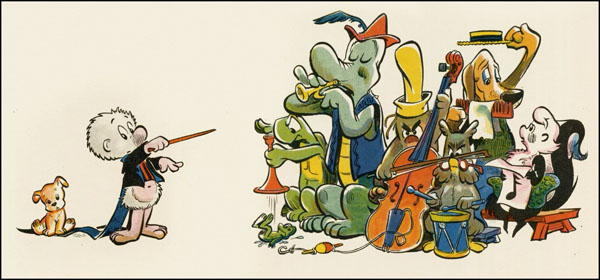
The main page described the proposed production: “The one hour TV film in color will be produced by William Tytla Productions, Inc. William Tytla will serve as producer of Pogo.
“Richard Saunders is a producer at Tytla’s. He has spent the past twenty years working with the outstanding people in the theatre, radio and TV as actor, writer and producer. Saunders will work with Bill Tytla in producing POGO.
“POGO will cost approximagely $350,000 for a fully animated TV film in color running 52 minutes in length. A precise budget and schedule will be submitted to the client for his analysis and approval. POGO will take approximately eight months to one year to complete.”
Saunders had a long distance telephone conversation on January 6, 1960 with executives from 3M, an American multinational company, with a formal presentation scheduled for February. Unfortunately, 3M decided to pass on the project for undisclosed reasons but probably cost.
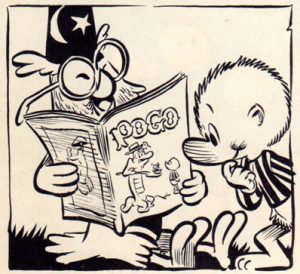 The POGO project continued to generate interest but with no company willing to put up the necessary money. On March 19, 1962, Tytla wrote to Lee Goldman of Quartet Films, Inc. in Hollywood: “On Friday, we had a nice meeting with Walt Kelly and he seems very enthused over the prospect of getting this into production. Very definitely, Walt will have to be consulted on anything of a musical nature, since the musical part will play an important role in this project.
The POGO project continued to generate interest but with no company willing to put up the necessary money. On March 19, 1962, Tytla wrote to Lee Goldman of Quartet Films, Inc. in Hollywood: “On Friday, we had a nice meeting with Walt Kelly and he seems very enthused over the prospect of getting this into production. Very definitely, Walt will have to be consulted on anything of a musical nature, since the musical part will play an important role in this project.
“When it comes to casting for voices, Walt feels very strongly as to what they should sound like. During our meeting, Walt mentioned his desire to do a storyboard. Lee, we’re very happy about this progress. As soon as we have a storyboard, we will contact you.”
In 1962, Tytla had taken a sabbatical from his company and was in Hollywood at Warner Brothers directing the animation on The Incredible Mr. Limpet (1964) since live action filming had begun on the back lot in July 1962. However, he was still actively trying to get the POGO project started.
He wrote to Kelly: “Just a ‘quickie’. A couple of weeks ago, I had lunch with two important Leo Burnett Agnecy men – one, Wendell Williams of the Hollywood office; the other Lee Bland from the Chicago office. The lunch was very pleasnat and they seemed very interested in the POGO project.
“Hoping that you are comfortably ahead of your work schedule, also hoping like mad that you’re getting a Pogo storyboard ready for a presentation.”
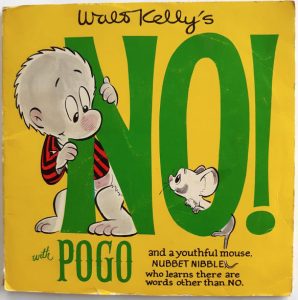 Kelly responded on August 8th, 1962: “The press of work continues and there’s no vacation in sight. A number of acute personal problems have siphoned off the remaining time. Inasmuch as the summer is about done and you should be back here for the fall, why not put off additional planning until then?
Kelly responded on August 8th, 1962: “The press of work continues and there’s no vacation in sight. A number of acute personal problems have siphoned off the remaining time. Inasmuch as the summer is about done and you should be back here for the fall, why not put off additional planning until then?
“Please reassure Bland et. als (sic) that I am interested but there’s only one of me right now. Maybe by September or October I may grow a third hand.”
Tytla wrote to Bland on August 14th, 1962 summarizing Kelly’s letter. Bland responded August 21, 1960: “Many thanks for updating us on Walt Kelly’s status. All is well and we shall stand by. Push the plunger when ready to reconvene and we’ll shake all three of Walt’s hands.”
Work on Limpett delayed Tytla from coming back to the east coast until the end of December. By then, Kelly had decided to abandon any further work on the animating of Pogo and his friends. Both Tytla and Kelly moved on to other projects.


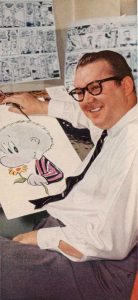
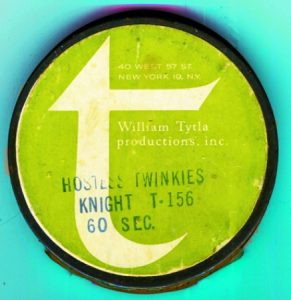
 Jim Korkis is an internationally respected animation historian who in recent years has devoted his attention to the many worlds of Disney. He was a columnist for a variety of animation magazines. With his former writing partner, John Cawley, he authored several animation related books including The Encyclopedia of Cartoon Superstars, How to Create Animation, Cartoon Confidential and Get Animated’s Animation Art Buyer’s Guide. He taught animation classes at the Disney Institute in Florida as well as instructing classes on acting and animation history for Disney Feature Animation: Florida.
Jim Korkis is an internationally respected animation historian who in recent years has devoted his attention to the many worlds of Disney. He was a columnist for a variety of animation magazines. With his former writing partner, John Cawley, he authored several animation related books including The Encyclopedia of Cartoon Superstars, How to Create Animation, Cartoon Confidential and Get Animated’s Animation Art Buyer’s Guide. He taught animation classes at the Disney Institute in Florida as well as instructing classes on acting and animation history for Disney Feature Animation: Florida.




















































Thanks for this very interesting article! Is there a outline, or a script, or any partially done storyboards in anyone’s archives? I’ve still never seen any of the later produced animated Pogo stories. I wish they’d come out on DVD/Blu-ray.
From what I saw when I got a chance to see the presentation folder is that the intent was to tie the special to the presidential election in 1960 with Pogo being drafted as a candidate. The artwork in the folder was all “clip art” from the strip. There was no original work done by Kelly. From what I was told, one of the reasons for the abandonment of the project was that Kelly never got around to doing or finishing the storyboard and didn’t want anyone else to do it.
Such a shame that this never was completed. It might have been quite good.
It’s interesting to speculate what a Bill Tytla production of Walt Kelly’s Pogo might have been like, and it’s tempting to wish that the special had been successful enough to establish Tytla’s studio as a contender in the television animation of the sixties. But frankly, given the state of television in the late fifties, I doubt whether the medium could have done it justice. Only a minority of TV stations were broadcasting in colour in 1960, a fact that influenced the colour palette of early TV cartoons (e.g., the yellow skies in early episodes of The Flintstones, because blue skies came across as too dark in black-and-white). Would Tytla and Kelly have had to make allowances for the limitations of the medium, and, if so, to what extent? We’ll never know.
By the way, that picture of Pogo conducting the Okefenokee Philharmonic — where is that from? I think it would make a great poster, like Hanna-Barbera’s “An Orchestra of Stars”.
That pic is from the title page of the book “Songs of the Pogo”.
https://thumbs.worthpoint.com/zoom/images1/1/1215/20/songs-pogo-walt-kelly-first-printing_1_840dadf52fc76e60df804687c912830a.jpg
Why is it that so often projects that “almost” happen sound more promising than the ones that actually do?
When I talked with Disney Imagineer Eddie Sotto about some of his projects for the Walt Disney Company that never developed beyond the proposal often with elaborate concept art or models, he laughed and said that “(those projects) never suffer budget cuts and always have the unfair advantage of being flawless in our imagination! There is no interference from others who want to put their imprint on it or have conflicting ideas.” I talked about some of his proposals in my book Disney Never Lands: Things Disney Never Made that has a section on unmade animation projects, some of which I have shared here at this site.
I can’t imagine a 1960s made-for-TV production of Pogo getting it right. Hard to say; even if Kelly had his hands all over it, would these characters come to life in a way that would click with fans of the strip? Perceptions vary.
The only compelling animation derived from a syndicated comic strip was Popeye. Sez me.
I thought Peanuts was also pretty compelling. I mean why do they keep airing the holiday specials every year if they didn’t?
Obviously by 1969, Proctor & Gamble could see the possibilities that other sponsors of a decade earlier couldn’t. Of course, by then maybe Chuck Jones’s name was more recognizable than Tytla’s had been. (Does anyone know whether Jones was responsible for the animated P&G commercials that were a part of that special? I have a couple of cels from those, and Pogo’s design is quite different from the way he appeared in the body of the show.)
Looks like you never got a response to whether Jones had a hand in the P&G animation and cells….
Did Disney make any overtures to Kelly before mentioning it to a reporter? At the very least, Disney’s model of films that could be re-released for decades would have clashed with Kelly’s funhouse mirror to contemporary life.
From “Songs of the Pogo”: Kelly’s bio includes a list of early occupations ending with “an animator at Disney studios in Burbank, California.” The next sentence begins “He returned to the United States in 1941 in search of food …”
I wonder if “never was” is the appropriate term. The presidential election angle was eventually adapted by Kelly into the feature length claymation, “I Go Pogo” (which I thought wasn’t bad). Considering the amount of control Kelly liked to maintain over his characters’ projects, who’s to say the Tytla version would have turned out any much different (except for likely lesser animation quality from a fledgling studio on a TV pocketbook)? Perhaps “changed medium” is more appropriate than “never was”,.
Actually, the “I Go Pogo” stop-motion feature from 1980 was done without Kelly’s involvement. He passed away in 1973.
Rather strange that Disney was planning “Beauty and the Beast” in the ’50’s. Why was it abandon and does any concept art exist?
Of course, the realization of the studio doing a feature film based on that story wouldn’t happen till decades later (with wide success).
Supposedly, Walt felt that having two characters just sitting across from each other every night talking was not interesting enough. When Howard Ashman came up with the idea of having the objects in the castle also be enchanted and have individual personalities, it opened up story possibilities. Walt often bought properties not only to develop himself but to prevent others from obtaining and making a competing project. Sometimes just announcing he was working on something was enough at one time to scare others away from the story.
Apparently while working at Disney, Don Bluth saw some of the proposed work Disney had done on Beauty and the Beast. Early in 1984, Bluth began in earnest turning the story into an animated feature. It would have included Nan, the clairvoyant dog; Max, a bird detective; Otto an escape artist lizard; and King Bats, The Wee Beasties and Queen Livia (who changed the guy into a beast when he rejected her love). Beauty would have been blonde. When Disney announced their version, Bluth dropped his feeling he would not be able to complete it before Disney’s version appeared.
Beauty and the beast was in the planning stages much earlier. The story wad thought not suitable for animation back then.
I don’t understand how a Disney feature of Pogo was ever a possibility. Walt Kelly owned Pogo outright by 1955… so if he himself didn’t want Disney to do a cartoon, there’s no way they could have done it.
I found the Newsweek article on the Internet Archive. The part about “Beauty and the Beast” and “Pogo” was not presented as a quote from Disney, just that those projects were “possibilities.” Whether the reporter got that information from Walt himself, from someone else at the studio, or from sources elsewhere was not stated.
What about “Scruffy?”
I found this site/thread while trying to find more information about a Pogo film reel that was part of the Cypress Gardens film archive. While digitizing the 1,000’s of films in the collection, I found a large film reel with only the markings “We have met…”. It turned out to be a storyboard film with narration using the Pogo characters to tell the story of environmental damage to life in the Everglades.
The film was in decent condition and has already been scanned. The original is currently stored in cold storage. Does anyone have more info about this? I thought I read about a few versions and this seems to be a copy before certain parts were edited out.